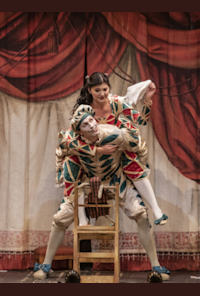


Il barbiere di Siviglia (The Barber of Seville), Rossini
Comhroinn
Deutsche Oper Berlin (2021/22)Faisnéis ón eagraíocht ealaíon (Fíoraithe ag Operabase)
23 Deaireadh Fómhair - 02 Eanáir 2021/22 (5 feidhmíochtaí)
Tabhair cuairt ar Suíomh Gréasáin|
Iodáilis
Gearmáinis/Béarla
The Barber of Seville by Rossini, Déa 28 Deai 2021, Ó (2021/2022), Faoi stiúir Katharina Thalbach, Seoltóir Matteo Beltrami, Deutsche Oper Berlin, Berlin, Germany
Amharc ar Theilgthe agus ar Chriú le haghaidh 28 Deai 2021
Léiritheoir
Conductor
Stage director
Caitheadh
Il Conte d'Almaviva
(The Count of Almaviva)
MN(2021 Deai 23, 28, 30)
Don Bartolo
(Doctor Bartolo)

(2021 Deai 23, 28, 30)
Rosina

(2021 Deai 23, 28, 30)
Figaro

(2021 Deai 23, 28, 30)
Don Basilio
Berta
Fiorello
Un ufficiale
(An officer)

(2021 Deai 23, 28, 30)
Un notaro
(A notary)
Criú
Librettist
Costume designer
Set designer
Chorus master
Ensemble
Ceolfhoireann
Tuilleadh eolais faoin gcumadóir
Tuilleadh eolais faoi obair cheoil





